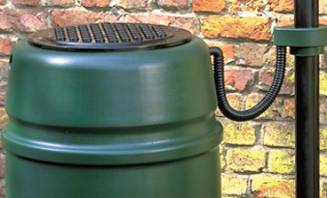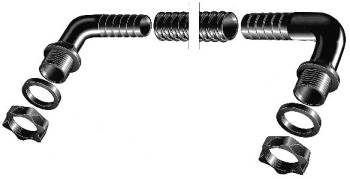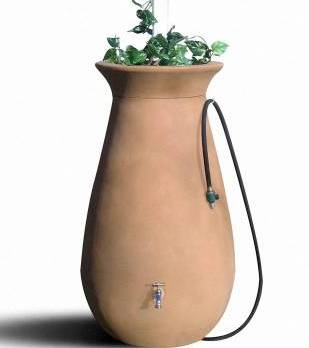The Best Water Butt for your Garden
Article by David Marks
Water butts are a simple method for collecting and storing rainwater. Typically In the UK, plants in the open only require hand-watering from late June to late August, if at all. At other times of the year natural rainfall is normally sufficient. Although rainfall is intermittent and unpredictable, the average area of ground has good, natural storage capacity, sufficient to even out the availability of water from September to June.
Plants in grow bags, containers and hanging baskets have much higher requirements for hand watering. This is because the plant foliage will disperse the water away from the compost in the container reducing the effect of natural rain water to surprisingly little.
The most common reasons for using water butts rather than tap water are:
- COST – many households now have water meters and this means you are paying for any water you use in your garden. Rainwater from a water butt is free and that can only bring a smile to the face of most gardeners.
- PLANTS PREFER RAINWATER – all plants benefit from natural rainwater compared to water from your taps. Tap water is a new source of water as far as plants are concerned, they have evolved over thousands of years on rain water. Some plants in particular, such as blueberries, will not grow successfully if watered repeatedly with water from your taps.
- AVAILABILITY – tap water is not always readily or easily available in some gardens / allotments. A water butt occupies very little room and it can be sited near to where water is required.
- ENVIRONMENTAL – tap water is commonly treated with chemicals such as chlorine and aluminium sulphate. Other chemicals are also frequently added such as fluoride. When water travels through older pipes it also picks up unknown levels of other substances which can be poisonous to plants.
Water butts come in all shapes and sizes, some even could be considered as garden features. The choice all comes down to cost, your personal preferences and needs.
WATER BUTT SIZES
The smallest water butts sold have a capacity of 100 litres; the largest ones are generally in the range 1,500 to 2,000 litres. The larger tanks can be as high as 200cm / 80in with a base 120cm / 48in. The smaller tanks are typically 130cm high (including stand) and 35cm / 14in wide.
Below are a couple of estimates of water requirements to give you some idea of the water butt size you may require. They are estimates only; temperature, other weather conditions and the size of plants may alter water requirements significantly. The estimates are made assuming hand-watering is required only during warm, dry weather typically occurring in an average UK summer:
- Grow Bag with two tomato plants – approximately 3 litres / 5.5 pints per day in warm weather. Assume in the region of 200 litres during the growing period.
- Medium sized hanging basket – approximately 1.5 litres per day in warm weather depending on the construction of the basket and the amount of plants in it. Assume in the region of 100 litres during the growing period
- An open bed sized 2m by 2m with shallow rooted plants – approximately 3 litres per day. This can vary considerably depending on the type of ground, weather conditions and the plants being grown. Assume in the region of 200 litres during the growing period. Note that many shrubs and almost all trees need almost no manual watering.
A 200 litre capacity plastic water butt can be lifted by the average adult without a problem. If you get beyond that size, or the material is not plastic, then you may need two people. Also consider access size – some of the larger capacity water butts are too big for a front door or the average garden gate.
If costs are important then it is often the case that buying online is not only more convenient, it is often cheaper. A trip to a DIY store may well work out more expensive compared to the delivery charges of a reputable online supplier, see here for example.
The other principal variable which affects the water capacity required, is the size of the area where water is collected from, as described in the next section.
WATER COLLECTION IN THE GARDEN OR ALLOTMENT
If you leave a typical water butt out in the open over autumn and winter it will collect very little water by the time June arrives. In our experience the average water butt will collect maybe 45cm / 18in of water. The open area at the top is simply too small to be an effective trap for rain water.
By far the most common method for the UK gardener, which enables large quantities of rain water to be collected, is place the water butt next to a building which has guttering. The roof of the building will collect large quantities of water into the guttering. A simple attachment is then placed into the downpipe guttering to divert the water into a water butt.
The picture below shows such a device which has the distinct advantage that the water butt does not need to be immediately next to the gutter downpipe. The flexible connecting tube can be ordered in different lengths to suit almost any situation. If the water butt fills up, water is automatically diverted back down the existing gutter downpipe. Click here if you want to order this device.

Any building with guttering can be used – a house, a shed, a greenhouse or a garage. If the building / structure does not have guttering there are several cheap kits available from diy and hardware stores which do an excellent job.
The average rainfall in the UK is about 80cm 32in each year. On that basis, and assuming you can collect 75% of that rainfall, a roof of 2 metres (6ft) width and depth will collect 3,200 litres of water each year. Much of this will be collected in the period October to April.
When estimating the size of water butt best for your situation don’t forget that you can start with one water butt and add another one later. You simply need a connector kit which can be found here. The hose which connects the two water butts can be as long or as short as you want.
It may sound counter-intuitive to buy two smaller water butts and connect rather than one larger water butt. however, when you start to get water butts much above 200 litre in capacity it is actually cheaper to buy two smaller ones. See this page here to compare prices of different for different water capacities.

Connector kit
Installing a connector kit or a water diverter can involve drilling a hole into the water butt if there isn’t one already present or they are different sizes. This is not a problem for the average diy person however it can be avoided altogether if you start off with a water butt from a major supplier and then buy one of the same brand later.
You can then add further water butts / connectors etc. using the pre-drilled holes. If you drill a hole into a water butt incorrectly it can be repaired with silicon sealant but the join will never be totally reliable.
SETTING UP A WATER BUTT
To use a water butt many situations will involve filling up a watering can from its tap. Because the taps are low down you will need to raise water butt high enough to get a watering can under the tap. The obvious option is to buy the “optional” stand for the model you choose.
The other option is to raise the water butt up by laying it on bricks or similar materials. The support needs to be solid because the weight of 200 litres of water is very heavy.
The ground below the water butt needs to be level and reasonably solid. You don’t want the weight to allow it to settle in the ground unevenly which could result in it tipping over. If you can avoid areas where leaves fall, all the better.
The position also needs to be near enough the water source, normally a guttering downpipe against a wall, to connect up the water diverter from the downpipe to the water butt. Follow the instructions which come with the water diverter to connect it up.
APPEARANCE
Plastic water butts are strong, light, cheapest of all and last for a very long time. Green or black are the normal colours. If appearances are key you may want choose a different look.
All are more expensive compared to the plain black or green plastic but remember, a water butt will be a permanent feature in your garden or allotment. Spending a little more at the outset will buy you a much better looking water butt.

Terracotta effect
For those who want something slightly more decorative but with all the benefits of plastic the terracotta effect water butt above should fit the bill perfectly. It has a 245 litre capacity, a brass tap and a planter at the top all included.
COMMENTS / QUESTIONS LEFT BY OUR READERS
ANSWER: Not that I know of. Any water collection system needs a surface to collect water, a roof or even a tarpaulin. That surface must be higher than the water butt.
I have the same problem with my allotment, I have no shed. But I do have a source of water, a stream. I decided to invest in a petrol generator and a water pump. That allows me to pump water from the stream to the many water butts on my allotment. Probably unlikely in your case but if you can collect water in one or more water butts near your house and then pump it via a hose to your garden, that would work. But there is a significant initial investment cost.
For me it’s worth it because the allotment is my main hobby. The generator is also an insurance policy for power cuts at home.
The only other comment i will make is about mulching. To reduce the need for pumping water from the stream, much of my allotment is heavily mulched. This reduces the need for watering hugely, far more than you would ever imagine.
In spring a few years ago, when the ground was damp, I applied a layer of cardboard to the ground, sometimes cut around existing fruit crops. I then covered the cardboard with wood chip – a layer of about 8cm. The wood chip is sourced for free from a local tree surgeon. But for smaller areas, bark chip etc can be bought from the local diy store. Any shrub pruning material is also ideal.
Having laid the mulch down initially, I top it up a little every year. I estimate that it removes the need for watering by about 80%. I not only use it on the allotment but also in my small garden with the same results.
ANSWER: Is the water butt covered? If not cover it and that may solve the problem.
If it is covered then the problem must be the water going into the water butt. If lots of leaves are going into the butt with the water, they will begin to decompose and make the water smell. What you need to do is place some from of mesh at the top of the downpipe from the shed roof to stop the leaves getting into the water butt.
ANSWER: If the water in the water butt is initially clean and it is covered by a top which stops light and debris getting in then it will, in normal circumstances, last over a year.
WHY NOT LEAVE YOUR QUESTION / COMMENTS ABOUT THIS PAGE?
ENTER THEM BELOW. EMAIL ADDRESS IS OPTIONAL.
YOUR COMMENTS WILL BE ADDED ABOVE WITHIN A FEW HOURS.
[contact-form-7 id=”1882″ title=”Contact form 1″]